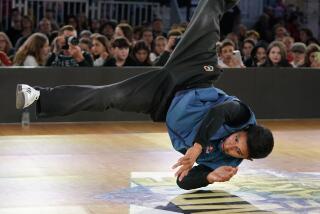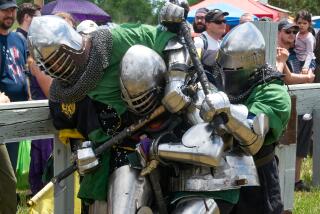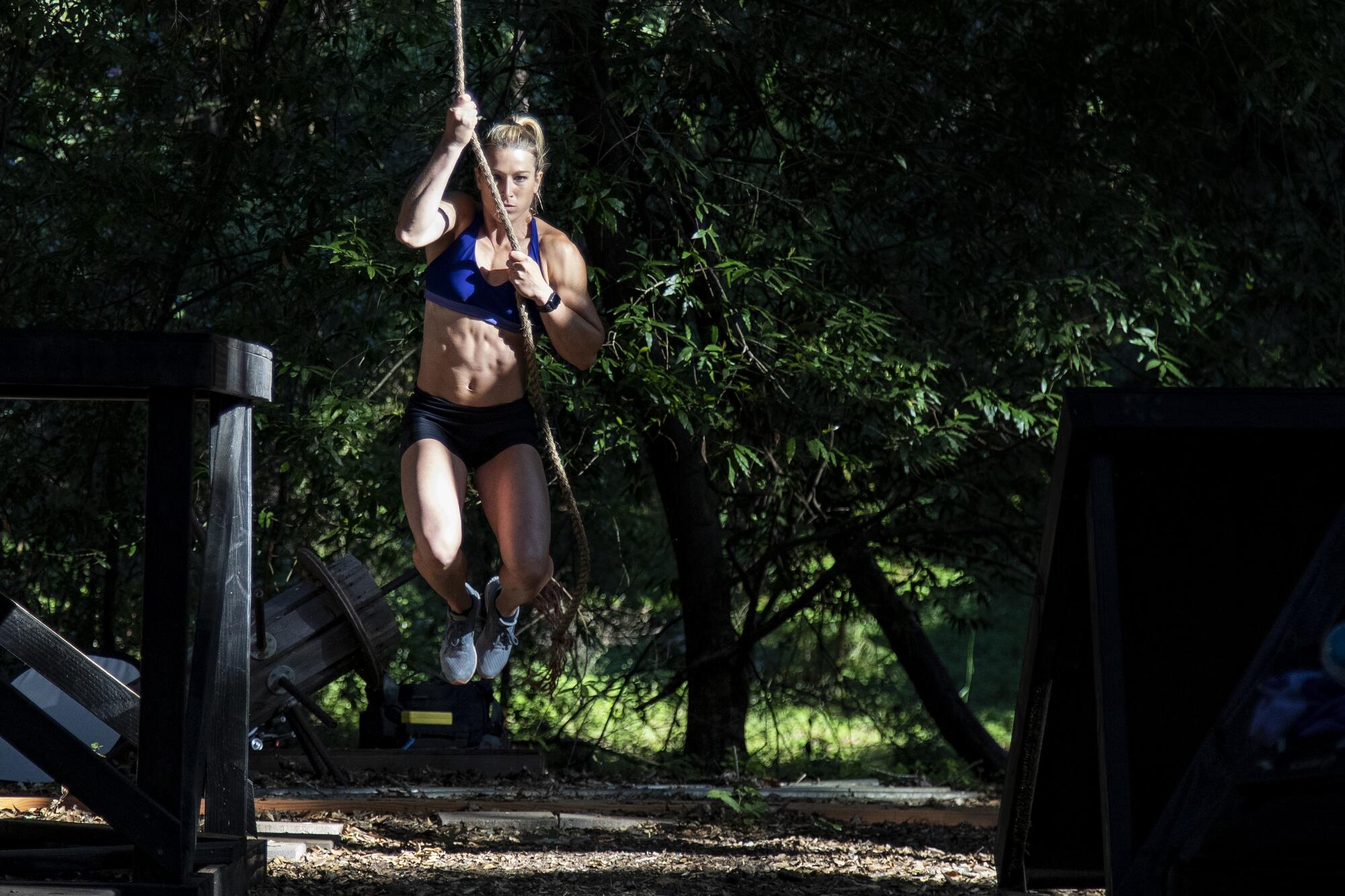
- Share via
SCOTTS VALLEY, Calif. — The place is hard to find. You must drive into the mountains above Santa Cruz, following a road that turns from asphalt to dirt, then park at the top of a rise and look for a path whose entrance is deliberately concealed by brush.
A handful of men and women arrive here on a weekday afternoon in late spring, tramping through tall pines and occasional poison oak to get to an odd sort of playground.
Fashioned from plywood and metal pipe, the makeshift obstacle course looks like a children’s jungle gym, only larger and considerably more dangerous. The man who built it offers his guests a word of advice.
“You have to go hard,” David Campbell says. “Like you mean it.”
Everyone laces up their shoes and soon they are swinging from ropes that hang from trees and scrambling up a sheer wall, reaching for the ledge on top. A mini-trampoline launches them toward rings that dangle overhead.
The practice session continues for hours as Campbell and his friends prepare for the season finale of “American Ninja Warrior,” a summer reality show that has contestants racing through obstacle courses in various cities, hoping to make it to the national finals in Las Vegas where they can win $1 million by finishing the last stage.
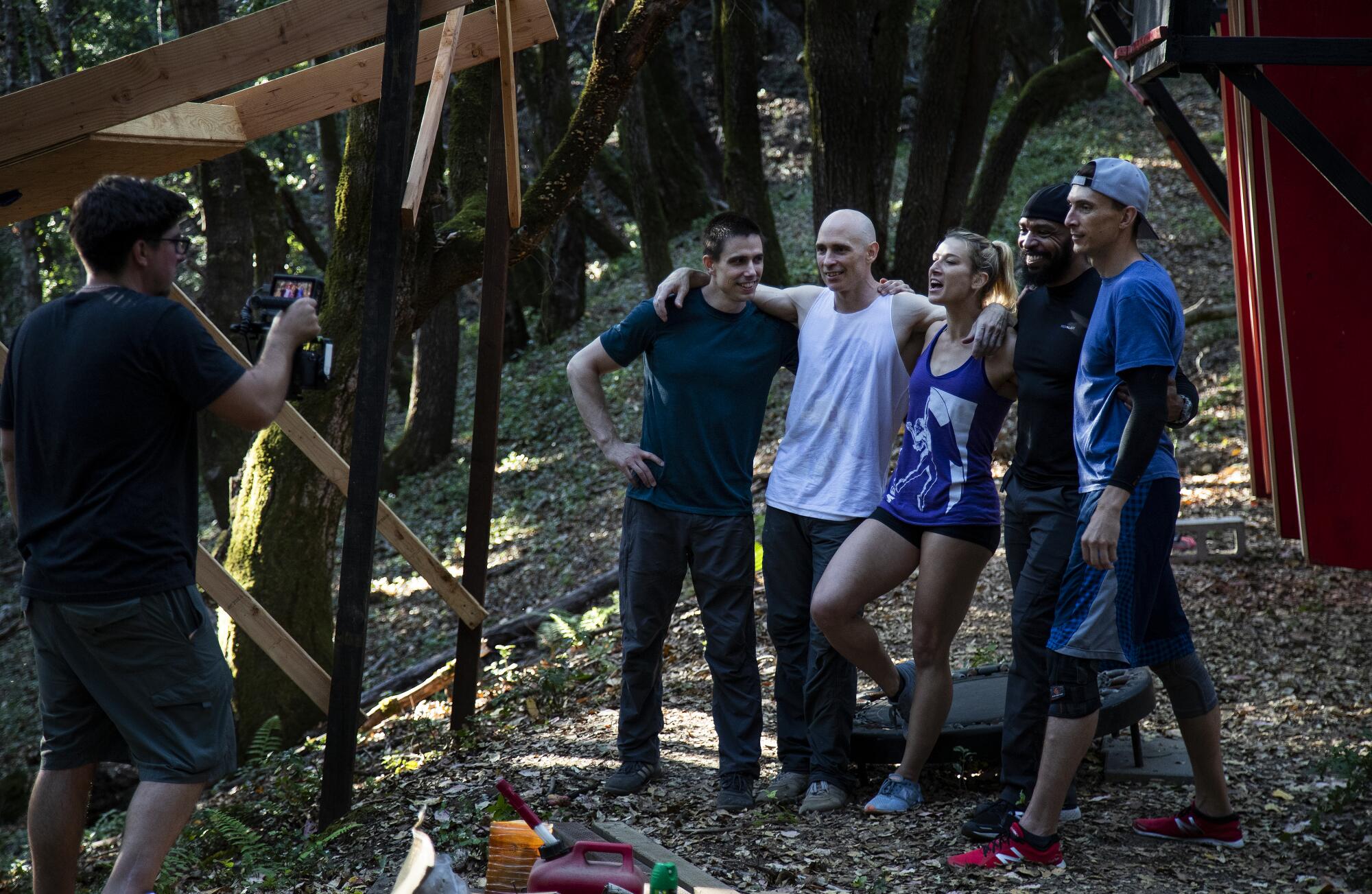
Only two people accomplished that feat through the first 10 seasons, but difficulty is part of the allure.
The NBC series has fostered a subculture of athletes who love testing themselves against the quirky, daunting obstacles. Some are former high school gymnasts or college track stars who are hungry to keep competing; others grew up strong and fast but never quite fit with traditional sports.
Finding a niche community to call home, they train in specialized gyms that have popped up across the country or maybe they wrangle an invitation from Campbell, a trim 41-year-old they call “The Godfather.”
Shortly before the national finals -- which were taped in June and begin airing next week (Aug. 26) -- he convenes a workout at his homemade course. Brian Kretsch shows up, along with a Catholic lay worker known as the “Papal Ninja” and a stuntwoman, Jessie Graff, who ranks among the top female competitors.
Most everyone is nursing sore shoulders and creaky ankles at this point in the year. It hurts when they miss a step or lose their grip on a high bar, tumbling to the ground, rising slowly to brush themselves off.
“I call it the joy of finding your limits,” Graff says. “Of hanging onto an obstacle until everything is trembling and still refusing to let go.”
::
The idea came from Japan, from a game show called “Sasuke” that debuted in the late 1990s with a mammoth course dubbed “Mt. Midoriyama.” Arthur Smith heard about it from a friend.
“I loved it,” he recalls. “I loved the athleticism.”

For ‘American Ninja Warriors,’ the course is a common enemy, drawing them together and compelling them to train year-round.
A former network executive who started his own production company, Smith devised an American version that has grown to include qualifying events and regional finals, all feeding into the Las Vegas championship. Some obstacles have been borrowed from the Japanese; others have been created by a team of U.S. designers.
The courses demand an array of skills.
Competitors need explosiveness to charge up the 14½-foot “Warped Wall” and grip-strength to navigate the “Cliffhanger,” where they hang by their fingertips while swinging from a series of ledges. The “Jumping Spider” forces them to leap into a narrow corridor and catch themselves by jamming their outstretched hands and feet against the walls on either side.
These acrobatics take place high above ground; most runs end with a trip or slip, the contestant flailing into a pool of water below. If you’re soaked, you’re out.
“You want a little bit of success, but it can never be easy,” Smith says. “We have a warehouse where the obstacles are prototyped and we bring in people who are Ninja-types to do the testing.”
The first few seasons, “American Ninja Warrior” aired on G4, a now-defunct cable channel that focused on the world of video gaming. The audience was young, male and of a particular ilk.
Then, Kretsch worked at a door company that went out of business. Built tall and lanky, a swimmer and soccer player in his youth, he stumbled upon the show by chance.
“I wasn’t doing anything else with my time,” he says. “I figured I might as well try it.”
Campbell tells a similar story. His house had burned down and he was staying with his brother, who had cable. He says: “There was a void in my life.”
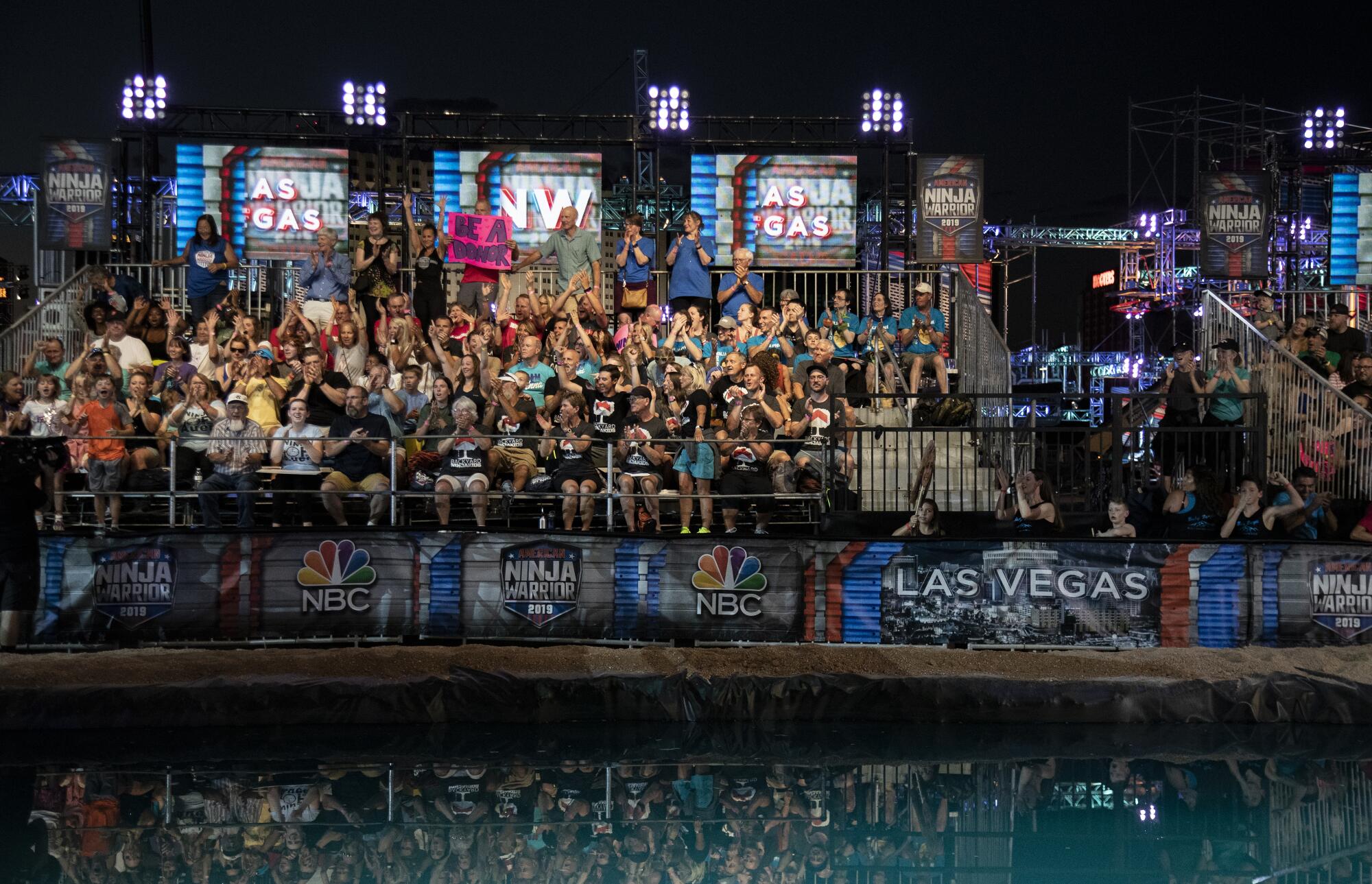
None of the early contestants guessed “American Ninja Warrior” would become a network success, picked up by NBC where it is now a staple of the summer lineup. They never imagined that, in addition to invited athletes, hundreds more would line up for a chance to compete in local qualifiers.
The “walk-ons” used to camp on the sidewalk for a week or more; those lucky enough to be chosen often felt achy at the starting line. Now, in the series’ 11th season, producers have established a lottery system.
“There’s a real community of people who do this,” Smith says. “That’s the magic of the show.”
::
A day after training in the mountains, Campbell and the others reconvene two hours north, at a converted warehouse near Oakland. Like other ninja gyms, it has padded floors and overhead rigging with hooks, rings and ropes that can be rearranged to approximate various obstacles.
Practice is supposed to begin around dinnertime, but the group spends more than an hour debating over how, exactly, to set up the course.
“These are the conversations we have,” Graff says, growing antsy. “It’s a ninja thing.”
Blame the producers, who constantly switch and substitute obstacles, keeping each week’s configuration a secret until the last moment. Contestants endlessly theorize about what they might face next. As Campbell says: “It’s all about the beta.”
The term comes from climbing, where it refers to the skills required to scale a particular rock face. In “American Ninja Warrior,” it might denote the correct arm position on the “Salmon Ladder” or the best technique for launching off a trampoline.
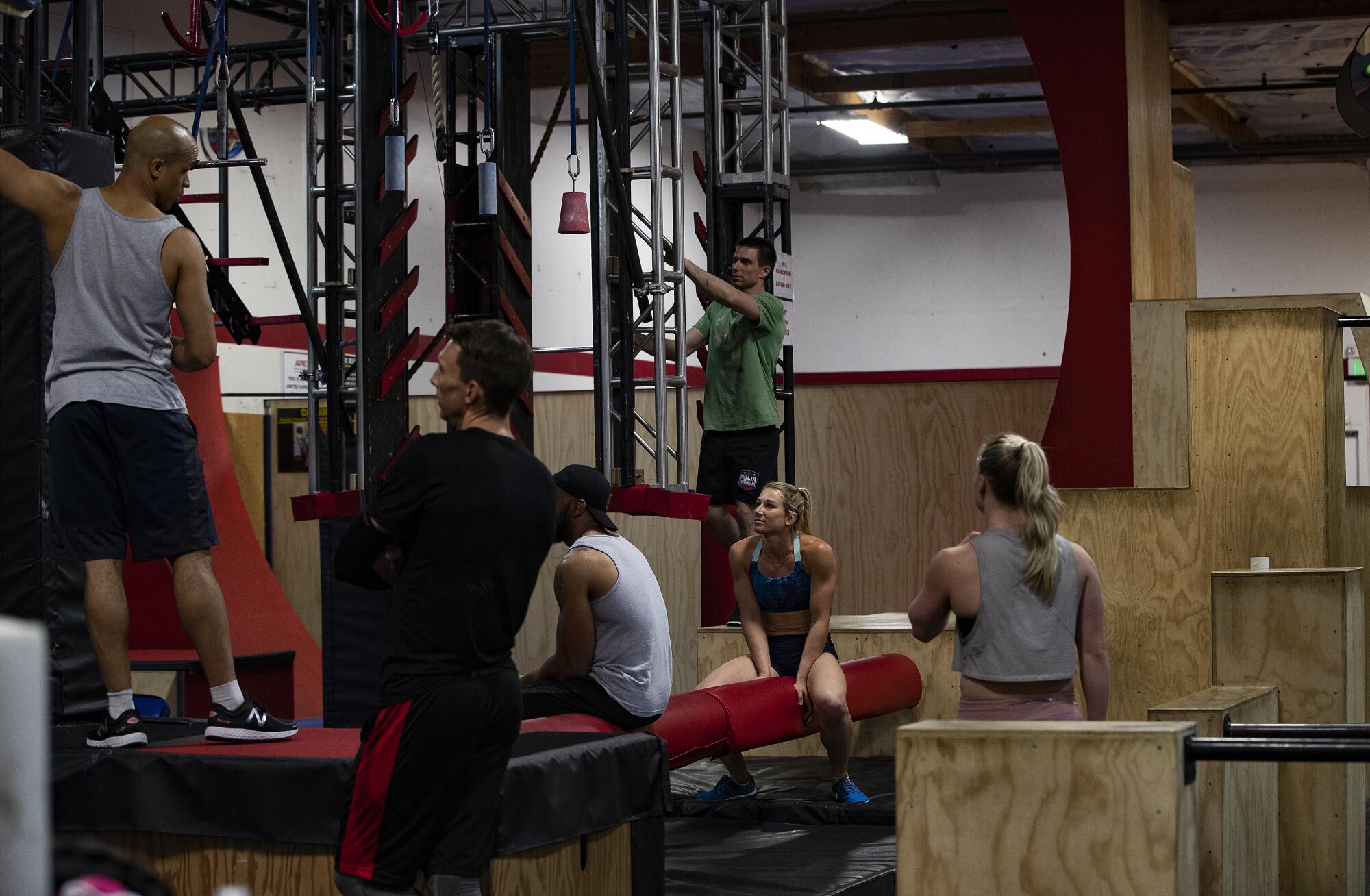
When practice finally begins at the Northern California gym, Graff and Kretsch discuss the art of the lache -- flying through the air from one high bar to another.
“You’ve got to use your hips,” Kretsch says. “Big hips.”
Contestants often share tips, perhaps because all of them -- tall and short, teenage and middle-aged, male and female -- face the same course on the same terms. As Graff puts it: “No asterisk next to my name.”
Camaraderie has helped all of them improve at training and figuring out obstacles, which has forced producers to adjust.
It might seem counterintuitive, but Smith insists that viewers want the show to be arduous; they want most seasons to end without a winner. He pushes his designers to be more devious.
Courses often include a “balance” element that requires sprinting across uneven steps, an unsteady bridge or a series of spinning blocks. Though no real strength or speed is required, these finicky obstacles can be the scariest.
“You make a tiny mistake,” Graff says, “and it’s over.”
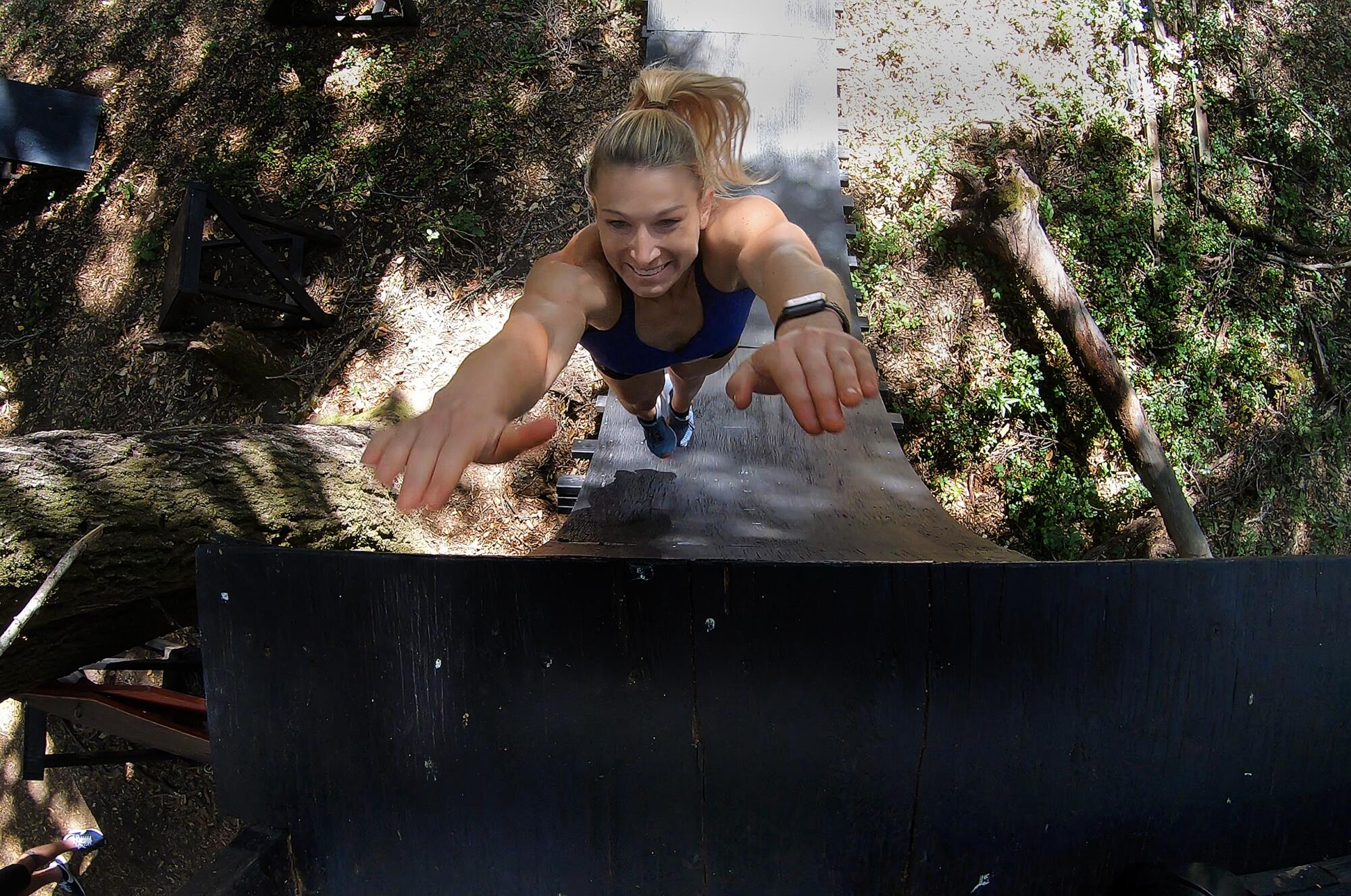
::
It figures that Akbar Gbajabiamila had an attitude. The former pro football player thought he had already seen the world’s best athletes when “American Ninja Warrior” brought him aboard as a color commentator in 2013.
“I came in with a little NFL arrogance,” he says.
A big man whose enthusiasm matched his defensive lineman’s size, Gbajabiamila joined something that purposely blurred the line between sport and entertainment.
The show usually tapes overnight, from 9 p.m. to sunrise, to facilitate dramatic lighting. Gbajabiamila and co-host Matt Iseman ham it up from their broadcasting platform, with lots of yelling and laughing.
“This isn’t scripted,” Gbajabiamila says. “But we’re telling a story.”
From the beginning, Smith knew “American Ninja Warrior” needed more than athleticism. He recalls walking into the first production meeting and asking: How do we sell the competitors?
It became apparent the show would attract a variety of people, with engineers and lawyers going up against guys who worked part-time jobs to leave room for training. Many showed up in colorful outfits and adopted nicknames such as “The Beast” and the “Bayou Ninja.”
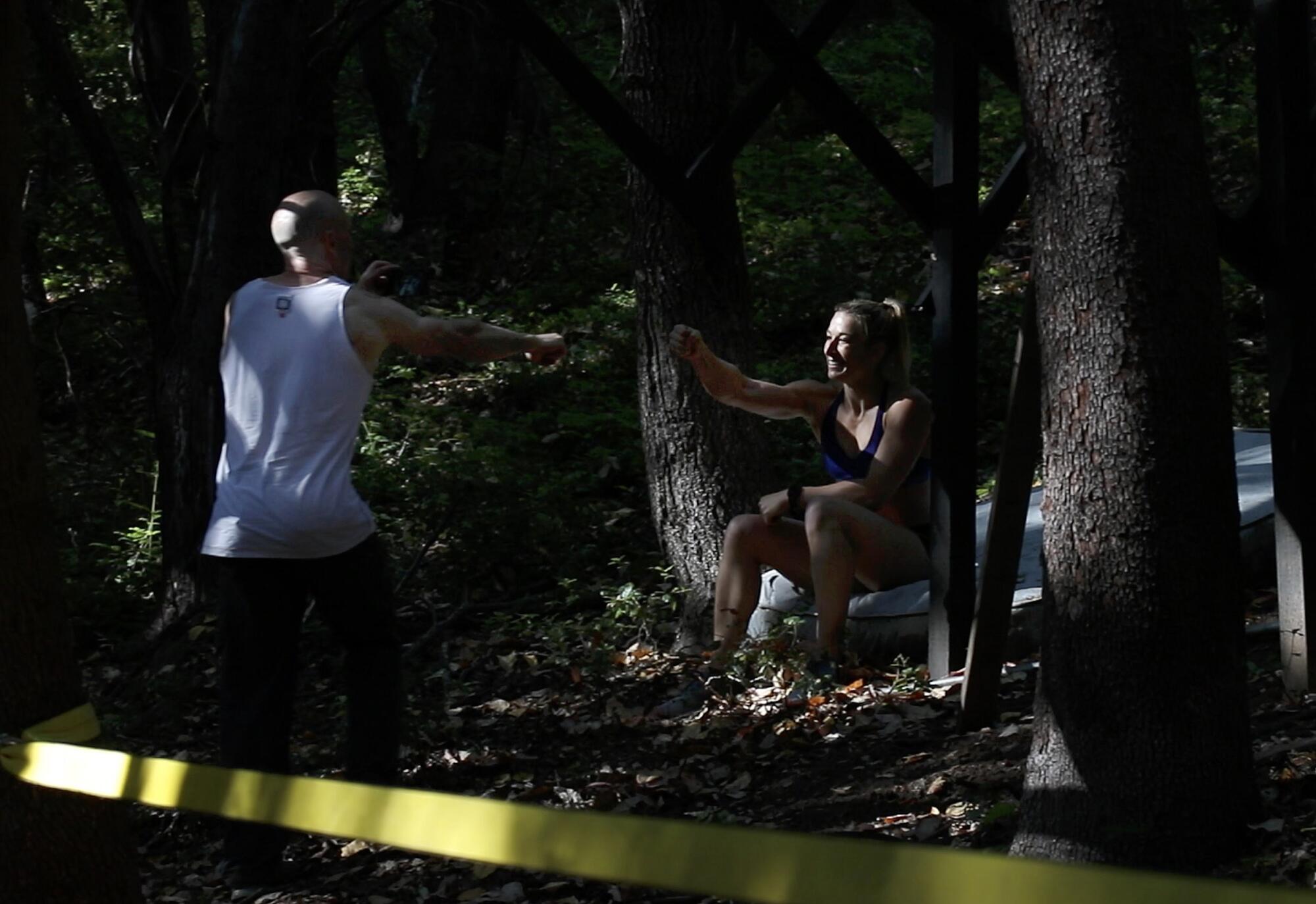
Smith figured he could market these personas through the sort of “up-close-and-personal” segments he had produced while supervising Olympic coverage for a Canadian network. Viewers learned about the “Cowboy Ninja” caring for a wife with multiple sclerosis, the “Island Ninja” losing his mother and “Ninja Phil” overcoming an autism spectrum disorder and chronic anxiety to compete. .
“What would the runs be without the stories?” Smith asks. “We’ve had so many great people overcoming things or changing their lives … you have to make viewers care.”
None of this should diminish the physicality of what happens on the course, Gbajabiamila says. When he joined the show, he recalls, “I started seeing these ninjas and it was like, ‘Hold on.’ ”
Column One
Column One is a showcase for compelling storytelling from Los Angeles Times.
Television cannot fully convey the size and scale of the obstacles, the distances to be jumped, the heights to be climbed. Football and basketball players tend to struggle; the best contestants are leaner and lighter, possessing a distinct skill set.
Gymnasts such as the “Papal Ninja” -- his real name is Sean Bryan -- do well because they know how to jump off trampolines and control their bodies in mid-air. Rock climbing, which requires length and strong hands, has produced the two most successful competitors.
Isaac Caldiero and Geoff “Popeye” Britten completed the finals course in 2015, with Caldiero taking the $1-million prize because he climbed the last, 75-foot rope three seconds faster. They are the only finishers so far, though NBC has now begun running commercials that state: This is the season history will be made. One ninja will win it all.
“In America, we believe traditional sports are the height of athleticism,” Gbajabiamila says. “I can tell you, there’s not a player in the NFL who can do what these ninjas are doing.”
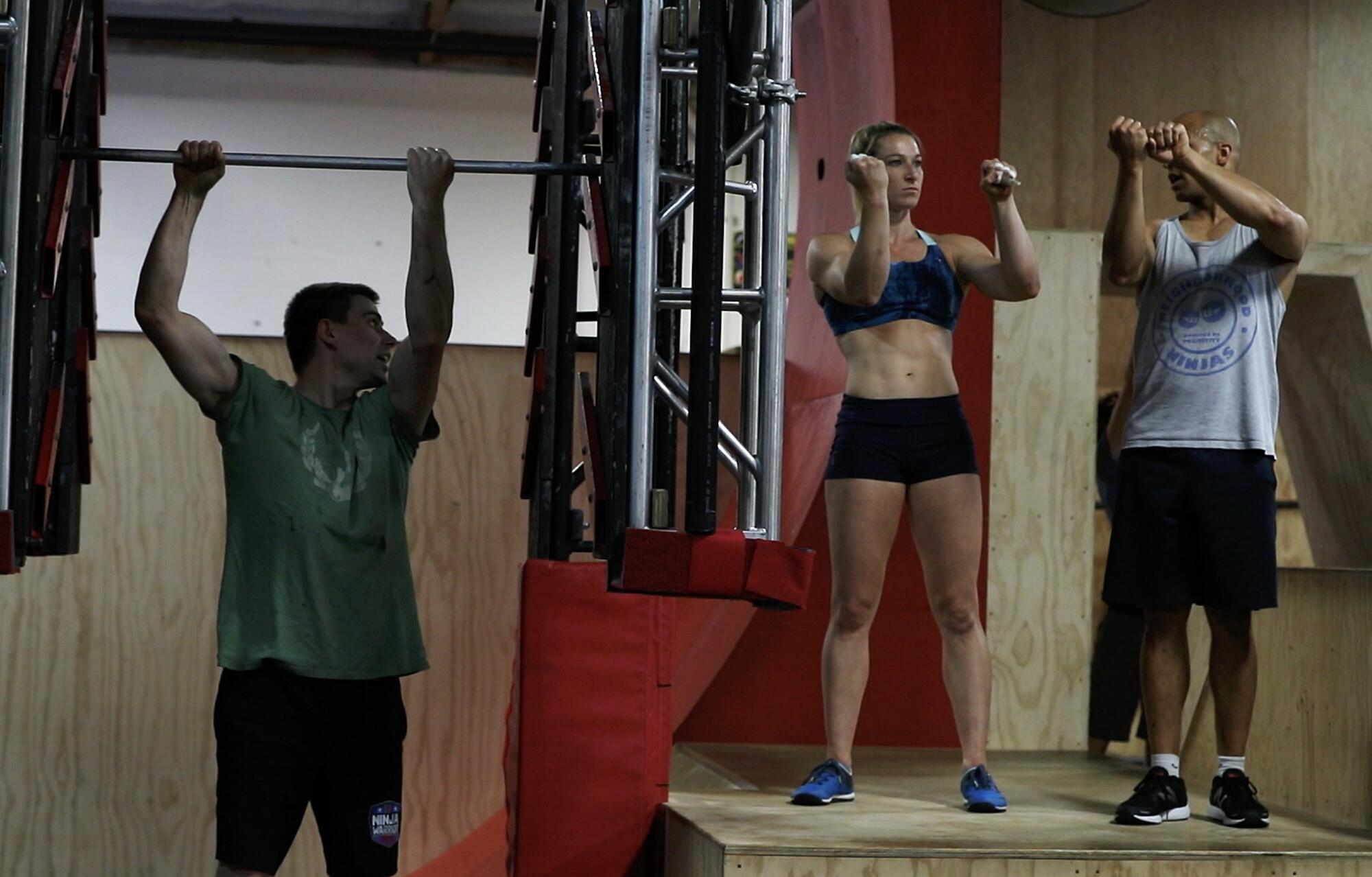
::
It is warm June evening, a week after Campbell and his friends trained in Northern California. All the finalists have traveled to Las Vegas, where they gather beside a vacant lot surrounded by covered fencing.
Inside, crews are putting the finishing touches on a four-stage course that rises from the dirt like a giant Erector set. Contestants stand on tip-toes or climb on each other’s shoulders for a glimpse.
“The obstacles have become more technical,” Kretsch says. “They keep giving us stuff we can’t emulate in the gym.”
Producers finally open the gates around dusk so everyone can watch testers take demonstration runs. The schedule has Campbell going relatively early at 10:30 p.m.; Graff is near the bottom of the list at 3:30 a.m.
“Waiting is always the worst part,” says Danell Leyva, a three-time Olympic medalist in gymnastics who switched to obstacle-course racing this year. “That’s when the nerves build up.”
...there’s not a player in the NFL who can do what these ninjas are doing.
— Akbar Gbajabiamila
There is a warm-up pen with high bars, some pads and dusty air that forces competitors to pull bandanas across their faces. When the taping starts, many of them crowd into the back corner where a monitor shows the action.
Darkness has transformed the course. All the dirt and miles of black television cable disappear under swirling, colored spotlights that glimmer off metal rigging. A crowd cheers from the bleachers as the first contestant bounds across a set of angled platforms, leaping to grab hold of a rope.
Things get trickier after that as he swings from one giant wheel to the next, then hangs from a bar that slides down a curved track known as “Double Dipper.” A slip and a splash ends his run.
I am not an outdoorsy person. I’m neither agile nor strong.
The fallen often pause on the walk back, still dripping wet, to shout encouragement at the next contestant. They stop by the warmup pen to offer a few pointers as the procession stretches until dawn.
The course is a common enemy. It is the thing that draws them together, compelling them to train year-round and obsess over details, all for the opportunity to challenge themselves a few nights each year. Waiting his turn, Kretsch tries to explain.
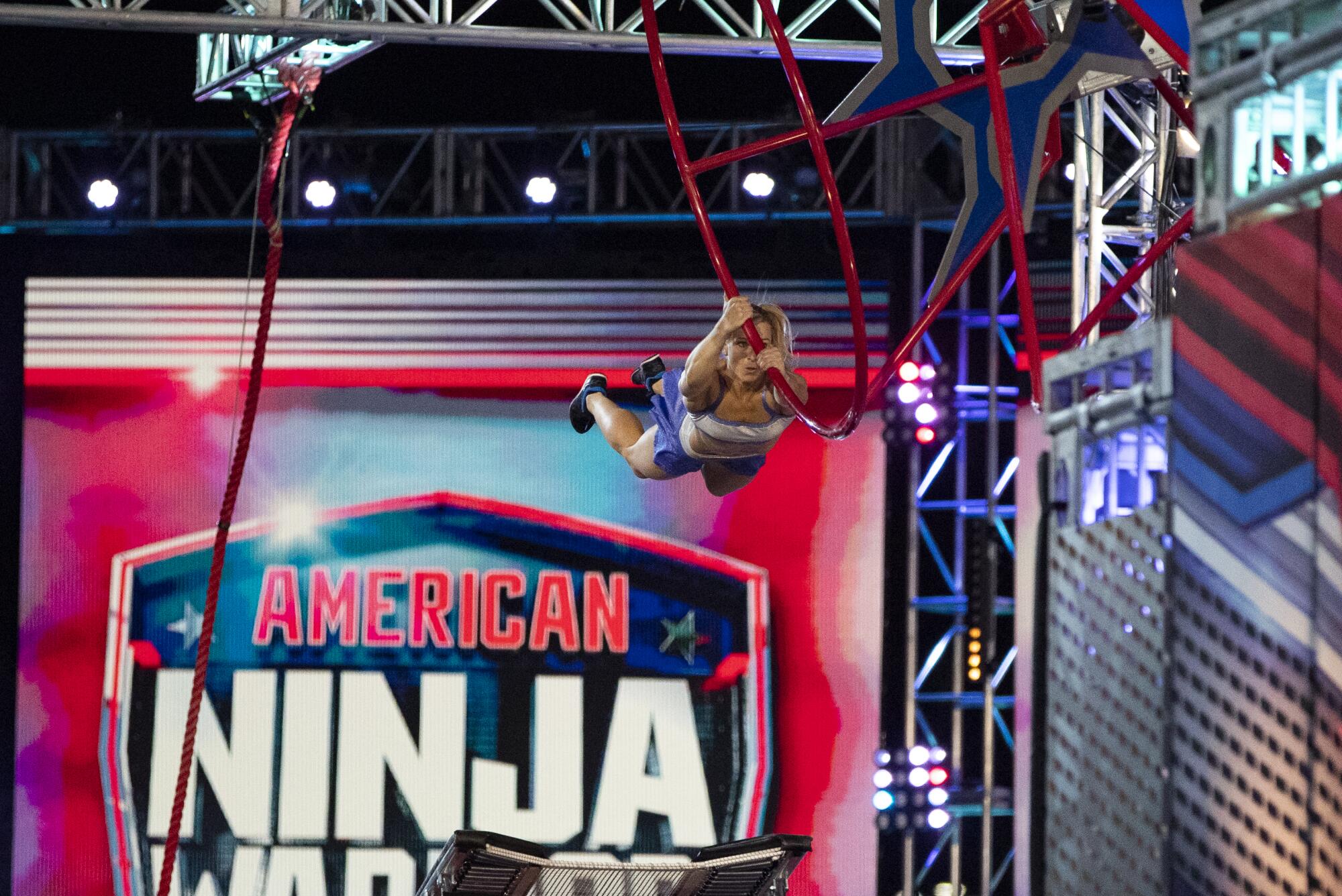
“In life, you have obstacles but you can’t always see the progress you are making,” he says. “You can’t always tell if you’re getting stronger.”
“American Ninja Warrior” is different. There are ledges to hang from and a warped wall to climb. There is a buzzer to hit at the end. Kretsch tugs at his sleeves and begins to stretch, getting himself ready.
More to Read
Go beyond the scoreboard
Get the latest on L.A.'s teams in the daily Sports Report newsletter.
You may occasionally receive promotional content from the Los Angeles Times.





